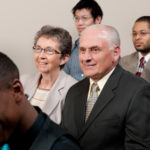WACO—Congregations that attempt to boost their racial and ethnic diversity may end up with fewer people in the seats, depending on how they handle change, a Baylor University study revealed.
The findings, published in the Journal for the Scientific Study of Religion, are based on an analysis of data from more than 11,000 congregations in the Evangelical Lutheran Church in America from 1993 to 2012, as well as data from the U.S. Census Bureau.
Process of change causes difficulties
While the diversity in the denomination doubled during the study period, average church attendance declined by 22 percent. ELCA churches that experienced the most racial change had the steepest drops in attendance, regardless of congregation age, region of the country or county population.
“Racial diversity itself is not a detriment to growth,” said lead author Kevin Dougherty, associate professor of sociology at Baylor. “It is the process of changing the racial composition of a congregation that causes difficulties.”
Findings noted
The study, “Congregational Diversity and Attendance in a Mainline Protestant Denomination,” found:
- Increases in racial diversity were associated with decreases in average weekly attendance, most notably in the 1990s.
- Older congregations were more likely to decline in attendance.
- Congregations in growing, predominantly white counties were more likely to grow.
The study is the first systematic test of a widespread notion that churches with members of the same racial or ethnic group are most likely to grow, with many church leaders believing churches can more efficiently serve members’ needs if they share the same culture.
Denominational administrative decrees not the answer
Sign up for our weekly edition and get all our headlines in your inbox on Thursdays
“That philosophy for a long time discouraged church leaders from striving for diversity,” said study co-author Gerardo Martí, associate professor of sociology at Davidson College.
“But in coming to terms with the historic racial segregation of American congregations, white pastors in the 1990s aggressively committed to overcoming discrimination, urging members to bring in those from ancestral backgrounds and reaffirm the gospel as rooted in relationships, unity and love. Racial diversity has become a central, and sometimes dominating, ambition for many white churches.
“Our research implicitly evaluates the effectiveness of denominational initiatives to ‘become diverse,’ revealing the extent to which such grand administrative calls for diversification lead to measurable success at the local level.”
In 1993, the ELCA issued a statement calling for leaders and congregations to repent of the sin of racism and advocate for racial justice in the community and congregations. Although the denomination has pushed to become more racially inclusive through ministries, missions and promotion of diversity within church staffs and leaders, still more than 90 percent of ELCA members are white.
New multiracial congregations best opportunity for diversity
As the U.S. population becomes more ethnically diverse, American congregations will face increased pressure to accommodate diversity inside their doors, researchers said.
“We conclude that new congregations started as multiracial represent the best opportunity for diversifying a denomination,” Dougherty said.
“It may be that nondenominational congregations may be more adaptable, since they do not have a denominational heritage to sustain.”
The researchers have begun to test those possibilities with data from other congregations.














We seek to connect God’s story and God’s people around the world. To learn more about God’s story, click here.
Send comments and feedback to Eric Black, our editor. For comments to be published, please specify “letter to the editor.” Maximum length for publication is 300 words.